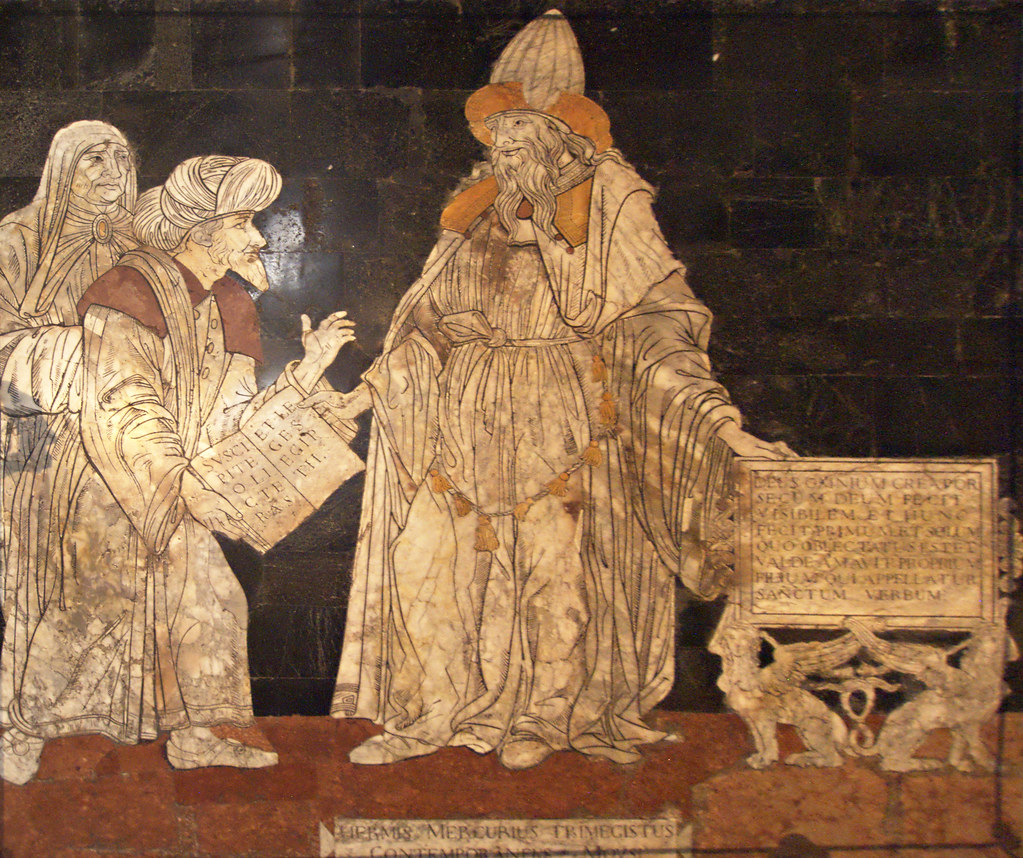
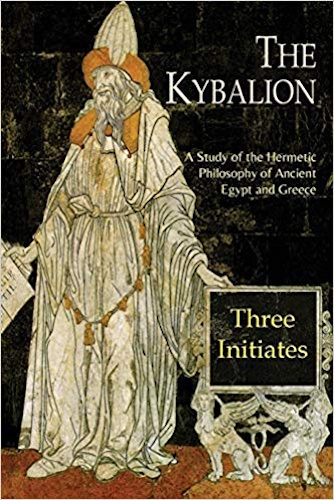

![Thrice-Greatest Hermes; Studies in Hellenistic Theosophy and Gnosis [Three Volumes in One] Thrice-Greatest Hermes; Studies in Hellenistic Theosophy and Gnosis [Three Volumes in One]](http://realityroars.com/images/affiliate-creative/thrice-greatest-hermes--studies-in-hellenistic-theosophy-and-gnosis.jpg)

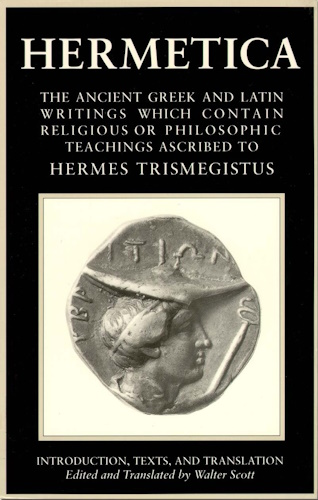



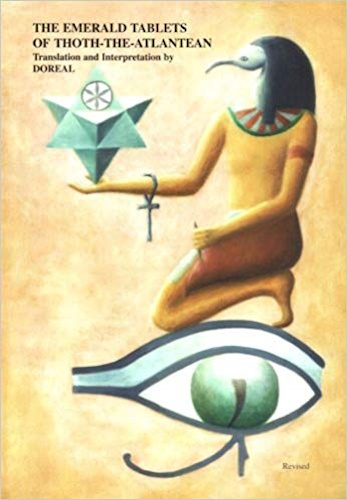

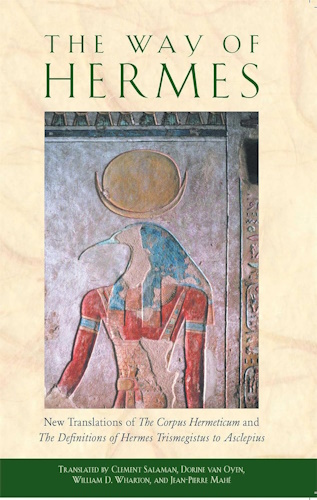

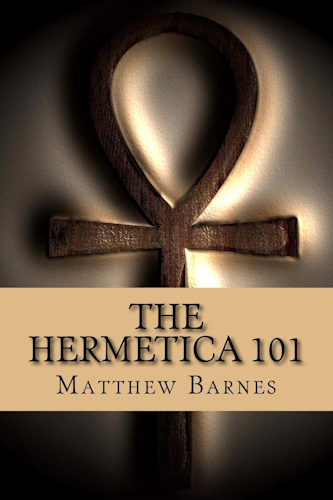

![]()
![]()
III. The Sacred Sermon
This brief and apparently somewhat garbled text recounts the creation and nature of the world in terms much like those of the Poemandres. The major theme is the renewal of all things in a cyclic universe, with the seven planetary rulers again playing a major role. - JMG
1. The Glory of all things is God, Godhead and Godly Nature. Source of the things that are is God, who is both Mind and Nature - yea Matter, the Wisdom that reveals all things. Source [too] is Godhead - yea Nature, Energy, Necessity, and End, and Making-new-again.
Darkness that knew no bounds was in Abyss, and Water [too] and subtle Breath intelligent; these were by Power of God in Chaos.
Then Holy Light arose; and there collected 'neath Dry Space <literally: "sand"> from out Moist Essence Elements; and all the Gods do separate things out from fecund Nature.
2. All things being undefined and yet unwrought, the light things were assigned unto the height, the heavy ones had their foundations laid down underneath the moist part of Dry Space, the universal things being bounded off by Fire and hanged in Breath to keep them up.
And Heaven was seen in seven circles; its Gods were visible in forms of stars with all their signs; while Nature had her members made articulate together with the Gods in her. And [Heaven's] periphery revolved in cyclic course, borne on by Breath of God.
3. And every God by his own proper power brought forth what was appointed him. Thus there arose four-footed beasts, and creeping things, and those that in the water dwell, and things with wings, and everything that beareth seed, and grass, and shoot of every flower, all having in themselves seed of again-becoming.
And they selected out the births of men for gnosis of the works of God and attestation of the energy of Nature; the multitude of men for lordship over all beneath the heaven and gnosis of its blessings, that they might increase in increasing and multiply in multitude, and every soul infleshed by revolution of the Cyclic Gods, for observation of the marvels of Heaven and Heaven's Gods' revolution, and of the works of God and energy of Nature, for tokens of its blessings, for gnosis of the power of God, that they might know the fates that follow good and evil [deeds] and learn the cunning work of all good arts.
4. [Thus] there begins their living and their growing wise, according to the fate appointed by the revolution of the Cyclic Gods, and their deceasing for this end.
And there shall be memorials mighty of their handiworks upon the earth, leaving dim trace behind when cycles are renewed.
For every birth of flesh ensouled, and of the fruit of seed, and every handiwork, though it decay, shall of necessity renew itself, both by the renovation of the Gods and by the turning-round of Nature's rhythmic wheel.
For that whereas the Godhead is Nature's ever-making-new-again the cosmic mixture, Nature herself is also co-established in that Godhead.


![Thrice-Greatest Hermes; Studies in Hellenistic Theosophy and Gnosis [Three Volumes in One] Thrice-Greatest Hermes; Studies in Hellenistic Theosophy and Gnosis [Three Volumes in One]](http://realityroars.com/images/affiliate-creative/thrice-greatest-hermes--studies-in-hellenistic-theosophy-and-gnosis.jpg)











-
Urantia Book, 44:0.11 - The Celestial Artisans
Never in your long ascendancy will you lose the power to recognize your associates of former existences. Always, as you ascend inward in the scale of life, will you retain the ability to recognize and fraternize with the fellow beings of your previous and lower levels of experience. Each new translation or resurrection will add one more group of spirit beings to your vision range without in the least depriving you of the ability to recognize your friends and fellows of former estates.
-
Princess Bride 1987 Wallace Shawn (Vizzini) and Mandy Patinkin (Inigo Montoya)
Vizzini: HE DIDN'T FALL? INCONCEIVABLE.
Inigo Montoya: You keep using that word. I do not think it means what you think it means. -
Urantia Book, 117:4.14 - The Finite God
And here is mystery: The more closely man approaches God through love, the greater the reality -- actuality -- of that man. The more man withdraws from God, the more nearly he approaches nonreality -- cessation of existence. When man consecrates his will to the doing of the Father's will, when man gives God all that he has, then does God make that man more than he is.
-
Urantia Book, 167:7.4 - The Talk About Angels
"And do you not remember that I said to you once before that, if you had your spiritual eyes anointed, you would then see the heavens opened and behold the angels of God ascending and descending? It is by the ministry of the angels that one world may be kept in touch with other worlds, for have I not repeatedly told you that I have other sheep not of this fold?"
-
Urantia Book, Foreword - 0:12.12 - The Trinities
But we know that there dwells within the human mind a fragment of God, and that there sojourns with the human soul the Spirit of Truth; and we further know that these spirit forces conspire to enable material man to grasp the reality of spiritual values and to comprehend the philosophy of universe meanings. But even more certainly we know that these spirits of the Divine Presence are able to assist man in the spiritual appropriation of all truth contributory to the enhancement of the ever-progressing reality of personal religious experience—God-consciousness.
-
Urantia Book, 1:4.3 - The Mystery Of God
When you are through down here, when your course has been run in temporary form on earth, when your trial trip in the flesh is finished, when the dust that composes the mortal tabernacle "returns to the earth whence it came"; then, it is revealed, the indwelling "Spirit shall return to God who gave it." There sojourns within each moral being of this planet a fragment of God, a part and parcel of divinity. It is not yet yours by right of possession, but it is designedly intended to be one with you if you survive the mortal existence.
-
Urantia Book, 1:4.1 - The Mystery Of God
And the greatest of all the unfathomable mysteries of God is the phenomenon of the divine indwelling of mortal minds. The manner in which the Universal Father sojourns with the creatures of time is the most profound of all universe mysteries; the divine presence in the mind of man is the mystery of mysteries.
-
Urantia Book, 1:4.6 - The Mystery Of God
To every spirit being and to every mortal creature in every sphere and on every world of the universe of universes, the Universal Father reveals all of his gracious and divine self that can be discerned or comprehended by such spirit beings and by such mortal creatures. God is no respecter of persons, either spiritual or material. The divine presence which any child of the universe enjoys at any given moment is limited only by the capacity of such a creature to receive and to discern the spirit actualities of the supermaterial world.
-
Urantia Book, 11:0.1 - The Eternal Isle Of Paradise
Paradise is the eternal center of the universe of universes and the abiding place of the Universal Father, the Eternal Son, the Infinite Spirit, and their divine co-ordinates and associates. This central Isle is the most gigantic organized body of cosmic reality in all the master universe. Paradise is a material sphere as well as a spiritual abode. All of the intelligent creation of the Universal Father is domiciled on material abodes; hence must the absolute controlling center also be material, literal. And again it should be reiterated that spirit things and spiritual beings are real.
-
Urantia Book, 50:6.4 - Planetary Culture
Culture presupposes quality of mind; culture cannot be enhanced unless mind is elevated. Superior intellect will seek a noble culture and find some way to attain such a goal. Inferior minds will spurn the highest culture even when presented to them ready-made.
-
Urantia Book, 54:1.6 - True And False Liberty
True liberty is the associate of genuine self-respect; false liberty is the consort of self-admiration. True liberty is the fruit of self-control; false liberty, the assumption of self-assertion. Self-control leads to altruistic service; self-admiration tends towards the exploitation of others for the selfish aggrandizement of such a mistaken individual as is willing to sacrifice righteous attainment for the sake of possessing unjust power over his fellow beings.
-
Urantia Book, 54:1.9 - True And False Liberty
How dare the self-willed creature encroach upon the rights of his fellows in the name of personal liberty when the Supreme Rulers of the universe stand back in merciful respect for these prerogatives of will and potentials of personality! No being, in the exercise of his supposed personal liberty, has a right to deprive any other being of those privileges of existence conferred by the Creators and duly respected by all their loyal associates, subordinates, and subjects.
-
Urantia Book, 54:1.8 - True And False Liberty
There is no error greater than that species of self-deception which leads intelligent beings to crave the exercise of power over other beings for the purpose of depriving these persons of their natural liberties. The golden rule of human fairness cries out against all such fraud, unfairness, selfishness, and unrighteousness.


